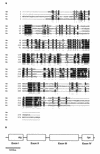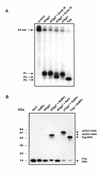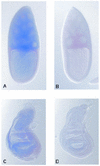Repair of oxidative DNA damage in Drosophila melanogaster: identification and characterization of dOgg1, a second DNA glycosylase activity for 8-hydroxyguanine and formamidopyrimidines
- PMID: 11095666
- PMCID: PMC115177
- DOI: 10.1093/nar/28.23.4583
Repair of oxidative DNA damage in Drosophila melanogaster: identification and characterization of dOgg1, a second DNA glycosylase activity for 8-hydroxyguanine and formamidopyrimidines
Abstract
In Drosophila, the S3 ribosomal protein has been shown to act as a DNA glycosylase/AP lyase capable of releasing 8-hydroxyguanine (8-OH-Gua) in damaged DNA. Here we describe a second Drosophila protein (dOgg1) with 8-OH-Gua and abasic (AP) site DNA repair activities. The Drosophila OGG1 gene codes for a protein of 327 amino acids, which shows 33 and 37% identity with the yeast and human Ogg1 proteins, respectively. The DNA glycosylase activity of purified dOgg1 was investigated using gamma-irradiated DNA and gas chromatography/isotope dilution mass spectrometry (GC/IDMS). The dOgg1 protein excises 8-OH-Gua and 2, 6-diamino-4-hydroxy-5-formamidopyrimidine (FapyGua) from gamma-irradiated DNA. with k(ca)(t)/K:(M) values of 21.0 x 10(-5) and 11.2 x 10(-5) (min(-1) nM(-1)), respectively. Enzymatic assays using oligodeoxyribonucleotides containing a single lesion show that dOgg1 displays a marked preference for DNA duplexes containing 8-OH-Gua, 8-OH-Ade or an AP site placed opposite a cytosine. The cleavage of the 8-OH-Gua-containing strand results from the excision of the damaged base followed by a ss-elimination reaction at the 3'-side of the resulting AP site. Cleavage of 8-OH-Gua.C duplex involves the formation of a reaction intermediate that is converted into a stable covalent adduct in the presence of sodium borohydre. dOgg1 complements the mutator phenotype of fpg mutY mutants of Escherichia coli. Whole-mount in situ hybridizations on tissues at different stages of Drosophila development reveal that the dOGG1 messenger is expressed uniformly at a low level in cells in which mitotic division occurs. Therefore, Drosophila possesses two DNA glycosylase activities that can excise 8-OH-Gua and formamidopyrimidines from DNA, dOgg1 and the ribosomal protein S3.
Figures






Similar articles
-
Excision of oxidatively damaged DNA bases by the human alpha-hOgg1 protein and the polymorphic alpha-hOgg1(Ser326Cys) protein which is frequently found in human populations.Nucleic Acids Res. 1999 Oct 15;27(20):4001-7. doi: 10.1093/nar/27.20.4001. Nucleic Acids Res. 1999. PMID: 10497264 Free PMC article.
-
Excision repair of 8-hydroxyguanine in mammalian cells: the mouse Ogg1 protein as a model.Free Radic Res. 1998 Dec;29(6):487-97. doi: 10.1080/10715769800300541. Free Radic Res. 1998. PMID: 10098454
-
Arabidopsis thaliana Ogg1 protein excises 8-hydroxyguanine and 2,6-diamino-4-hydroxy-5-formamidopyrimidine from oxidatively damaged DNA containing multiple lesions.Biochemistry. 2003 Mar 18;42(10):3089-95. doi: 10.1021/bi027226u. Biochemistry. 2003. PMID: 12627976
-
The human OGG1 gene: structure, functions, and its implication in the process of carcinogenesis.Arch Biochem Biophys. 2000 May 1;377(1):1-8. doi: 10.1006/abbi.2000.1773. Arch Biochem Biophys. 2000. PMID: 10775435 Review.
-
The OGG1 gene encodes a repair enzyme for oxidatively damaged DNA and is involved in human carcinogenesis.Antioxid Redox Signal. 2001 Aug;3(4):597-609. doi: 10.1089/15230860152542952. Antioxid Redox Signal. 2001. PMID: 11554447 Review.
Cited by
-
Solution structure of duplex DNA containing a β-carba-Fapy-dG lesion.Chem Res Toxicol. 2012 Nov 19;25(11):2423-31. doi: 10.1021/tx300290b. Epub 2012 Aug 29. Chem Res Toxicol. 2012. PMID: 22897814 Free PMC article.
-
Inhibition by 4-(4-Bromo-2-oxo-3H-benzimidazol-1-yl)-N-(4-iodophenyl)piperidine-1-carboxamide (TH5487) of the Activity of Human 8-Oxoguanine DNA Glycosylase-1 (OGG1) for the Excision of 2,6-Diamino-4-hydroxy-5-formamidopyrimidine, 4,6-Diamino-5-formamidopyrimidine, and 8-Oxoguanine from Oxidatively Damaged DNA.Biochemistry. 2025 Apr 15;64(8):1788-1796. doi: 10.1021/acs.biochem.4c00419. Epub 2025 Apr 3. Biochemistry. 2025. PMID: 40179276 Free PMC article.
-
Comparative analysis of context-dependent mutagenesis in humans and fruit flies.Int J Genomics. 2013;2013:173616. doi: 10.1155/2013/173616. Epub 2013 Aug 5. Int J Genomics. 2013. PMID: 23984310 Free PMC article.
-
Novel post-synthetic generation, isomeric resolution, and characterization of Fapy-dG within oligodeoxynucleotides: differential anomeric impacts on DNA duplex properties.Nucleic Acids Res. 2011 Jul;39(13):5776-89. doi: 10.1093/nar/gkr082. Epub 2011 Mar 16. Nucleic Acids Res. 2011. PMID: 21415012 Free PMC article.
-
Effects of ectopic expression of Drosophila DNA glycosylases dOgg1 and RpS3 in mitochondria.Free Radic Biol Med. 2006 Sep 1;41(5):757-64. doi: 10.1016/j.freeradbiomed.2006.05.021. Epub 2006 May 26. Free Radic Biol Med. 2006. PMID: 16895796 Free PMC article.
References
-
- Beckman K.B. and Ames,B.N. (1997) Oxidative decay of DNA. J. Biol. Chem., 272, 19633–19636. - PubMed
-
- Boiteux S. and Radicella,J.P. (2000) The human OGG1 gene: structure, functions and its implication in the process of carcinogenesis. Arch. Biochem. Biophys., 377, 1–8. - PubMed
-
- Breimer L.H. (1990) Molecular mechanisms of oxygen radical carcinogenesis and mutagenesis: the role of DNA base damage. Mol. Carcinog., 3, 188–197. - PubMed
-
- Feig D.I., Reid,T.M. and Loeb,L.A. (1994) Reactive oxygen species in tumorigenesis. Cancer Res., 54, 1890s–1894s. - PubMed
Publication types
MeSH terms
Substances
LinkOut - more resources
Full Text Sources
Other Literature Sources
Molecular Biology Databases
Research Materials
Miscellaneous

